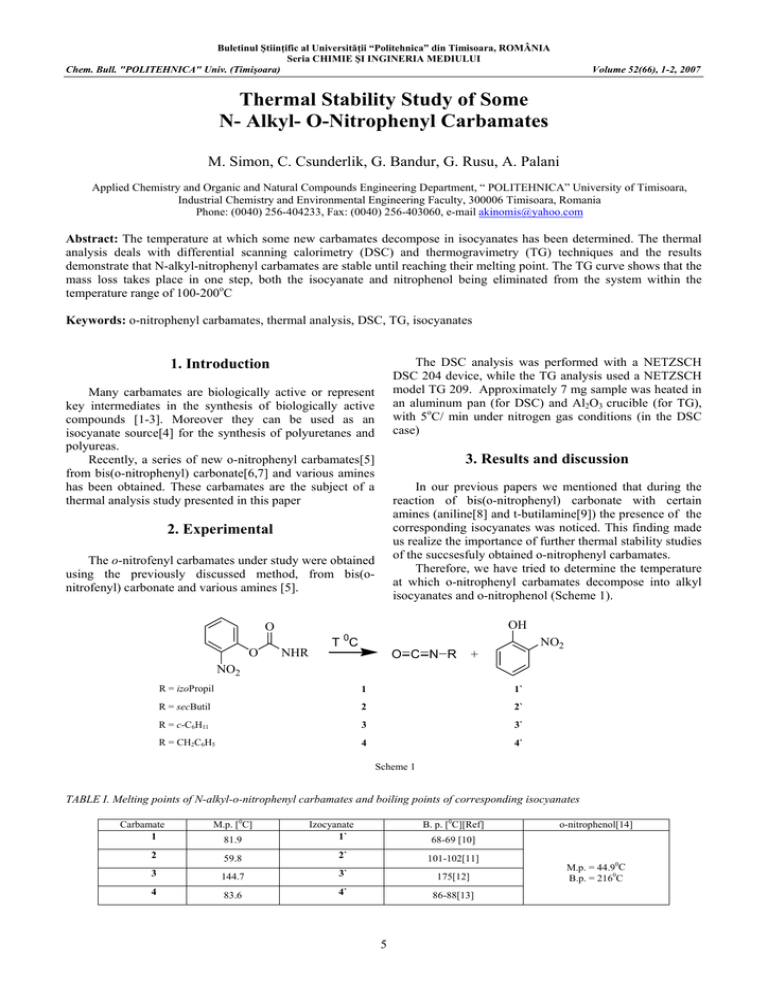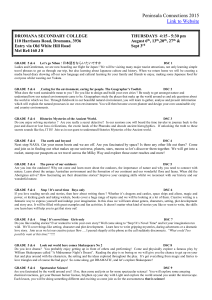Document 13359478
advertisement

Buletinul Ştiinţific al Universităţii “Politehnica” din Timisoara, ROMÂNIA Seria CHIMIE ŞI INGINERIA MEDIULUI Chem. Bull. "POLITEHNICA" Univ. (Timişoara) Volume 52(66), 1-2, 2007 Thermal Stability Study of Some N- Alkyl- O-Nitrophenyl Carbamates M. Simon, C. Csunderlik, G. Bandur, G. Rusu, A. Palani Applied Chemistry and Organic and Natural Compounds Engineering Department, “ POLITEHNICA” University of Timisoara, Industrial Chemistry and Environmental Engineering Faculty, 300006 Timisoara, Romania Phone: (0040) 256-404233, Fax: (0040) 256-403060, e-mail akinomis@yahoo.com Abstract: The temperature at which some new carbamates decompose in isocyanates has been determined. The thermal analysis deals with differential scanning calorimetry (DSC) and thermogravimetry (TG) techniques and the results demonstrate that N-alkyl-nitrophenyl carbamates are stable until reaching their melting point. The TG curve shows that the mass loss takes place in one step, both the isocyanate and nitrophenol being eliminated from the system within the temperature range of 100-200oC Keywords: o-nitrophenyl carbamates, thermal analysis, DSC, TG, isocyanates The DSC analysis was performed with a NETZSCH DSC 204 device, while the TG analysis used a NETZSCH model TG 209. Approximately 7 mg sample was heated in an aluminum pan (for DSC) and Al2O3 crucible (for TG), with 5oC/ min under nitrogen gas conditions (in the DSC case) 1. Introduction Many carbamates are biologically active or represent key intermediates in the synthesis of biologically active compounds [1-3]. Moreover they can be used as an isocyanate source[4] for the synthesis of polyuretanes and polyureas. Recently, a series of new o-nitrophenyl carbamates[5] from bis(o-nitrophenyl) carbonate[6,7] and various amines has been obtained. These carbamates are the subject of a thermal analysis study presented in this paper 3. Results and discussion In our previous papers we mentioned that during the reaction of bis(o-nitrophenyl) carbonate with certain amines (aniline[8] and t-butilamine[9]) the presence of the corresponding isocyanates was noticed. This finding made us realize the importance of further thermal stability studies of the succsesfuly obtained o-nitrophenyl carbamates. Therefore, we have tried to determine the temperature at which o-nitrophenyl carbamates decompose into alkyl isocyanates and o-nitrophenol (Scheme 1). 2. Experimental The o-nitrofenyl carbamates under study were obtained using the previously discussed method, from bis(onitrofenyl) carbonate and various amines [5]. OH O O NHR T 0C O C N R NO2 + NO2 R = izoPropil 1 1` R = secButil 2 2` R = c-C6H11 3 3` R = CH2C6H5 4 4` Scheme 1 TABLE I. Melting points of N-alkyl-o-nitrophenyl carbamates and boiling points of corresponding isocyanates Carbamate 1 2 M.p. [0C] 81.9 B. p. [0C][Ref] Izocyanate 1` o-nitrophenol[14] 68-69 [10] 59.8 2` 101-102[11] 3 144.7 3` 175[12] 4 83.6 4` 86-88[13] 5 M.p. = 44.90C B.p. = 2160C Chem. Bull. "POLITEHNICA" Univ. (Timişoara) Volume 52(66), 1-2, 2007 Based on the values presented in Table 1 we can state that iso-propyl isocyanate has a lower boiling point than the melting point of o-nitrophenyl carbamate from which it can be obtained, while benzyl isocyanate’s boiling point is very close to the melting point of N-benzyl-o-nitrophenyl carbamate. The other two isocyanates have higher boiling points as compared to the melting points of the corresponding o-nitrophenyl carbamates. The thermal analysis dealt with differential scanning calorimetry (DSC), which gives the temperatures at which physical or chemical transformations, endo-and exothermal, occur, and thermogravimetry (TG) techniques, which can determine mass loss as a function of temperature. The heating rate used for all these studies was 5oC/ min. From the DSC thermograms (Figures 1a-4a) it can be seen, as general characteristic, that only endothermal changes take place here and none of the analyzed samples decomposed before the melting point. The TG plots (Figures 1b-4b) show that mass loss (carbamate decomposition), occurred in only one step, the vaporization of the isocyanate and o-nitrophenol taking place almost in the same time. The DSC thermogram for N-iso-propyl-o-nitrophenyl carbamate (1) (Figure 1a) shows an endothermal peak at 81.9oC, corresponding to its melting point, and the decomposition starts at about 120oC, with the decomposition peak at 198oC. The TG curve (Figure 1b) shows that the mass loss starts at about 110oC and ends at 180 oC. N-sec-butyl-o-nitrophenyl carbamate (2) starts melting at the lowest temperature, 59.8oC, but the DSC thermogram (Figure2a) indicates that the decomposition only begins around 150oC, with a minimum at 214oC (the value at which o-nitrophenol boils), even though the boiling point of the isocyanate is 101-102oC. The TG plot (Figure 2b) shows that the mass loss occurs again in only one step, but it starts at approximately 100oC and ends at 200oC. In the N-cyclohexyl-o-nitrophenyl carbamate (3) case, we notice that the DSC thermogram (Figure 3a) displays two endotherm peaks: one that corresponds to the melting point (144.7oC) and a wider one at 218oC, from the decomposition process. According to the thermogram, the decomposition begins around 155-160oC. The TG plot indicates that mass loss starts at a temperature below 140oC and ends around 200oC. N-benzyl-o-nitrophenyl carbamate (4) has a melting point of about the same temperature (83.6oC) as the boiling point of the isocyanate (84-87oC) obtained from the decomposition. Still, the DSC thermogram (Figure 4) shows that the decomposition only starts around 120oC, and the wide peak whose minimum occurs at 207oC has a ‘shoulder’ at 159oC. This DSC thermogram best exemplifies the decomposition process, starting with the isocyanate elimination and followed by the o-nitrophenol elimination. In the TG plot (Figure 4b) we can observe that mass loss starts at about 110oC and ends at roughly 200oC. a) b) Figure 1. DSC (a) and TG (b) curves for the thermal decomposition of N-iso-propyl-o-nitrophenyl carbamate at 50C/min a) b) Figure 2. DSC (a) and TG (b) curves for the thermal decomposition of N-sec-butyl-o-nitrophenyl carbamate at 50C/min 6 Chem. Bull. "POLITEHNICA" Univ. (Timişoara) Volume 52(66), 1-2, 2007 a) b) Figure 3. DSC (a) and TG (b) curves for the thermal decomposition of N-cyclohexyl-o-nitrophenyl carbamate at 50C/min a) b) Figure 4. DSC (a) and TG (b) curves for the thermal decomposition of N-benzyl-o-nitrophenyl carbamate at 50C/min 3. Cotarcă, L. & Eckert, H. Phosgenations- A Handbook, Wiley-VCH Verlag GmbH&Co. Weinheim, 2003, 521-597. 4. Ozaki, S, Chem. Rev. 1972, 72, 457. 5. Simon, M., Csunderlik, C., Cotarcă, L., Căproiu, M.T., Neda, I., Turoczi, M. C., Volpicelli, R., Synth Commun., 2005, 35(11), 1471. 6. Simon, M., Csunderlik, C., Tirnăveanu, A., Rev. Chim., 2001, 52(7-8), 371. 7. Simon, M., Csunderlik, C., Jones, P.G., Neda, I., Fischer, A. K. Acta Cryst., 2003, E59, o688. 8. Simon, M., Micle, A., Turoczi, C. M., Badea, V., Csunderlik, C. Rev. Chim., 2006, 57(4), 383. 9. Simon, M., Csunderlik, C., Medeleanu, M., Dinache, A., Rev. Chim., 2002, 53(7), 535. 10. Kopper, A., Pongratz, L. Monatsch. Chem., 1933, 62, 89. 11. Siefken, W. Liebigs Ann. Chem., 1949, 562, 101. 12. Skita, A., Rolfes, H. Chem. Ber., 1920, 53, 1248. 13. Haworth, M.; Lamberton, A.; Woodoock, W. J. Chem. Soc. 1947, 186. 14. Dictionary of organic compounds 5th Ed. Vol. 4. Chapman and Hall, 1983, 4267. 4. Conclusions Based on all the above stated, we can conclude that these carbamates are stable at temperatures that are lower than their melting point. Therefore when they get to the decomposition temperature and split into isocyanate and onitrophenol, they leave the system almost in the same time, regardless of the difference in their melting point. REFERENCES 1. Adams, P.; Baron, F.A. Chem. Rev., 1965, 65, 596. 2. Ryan, T.A.; Ryan, C;, Seddon, E.A.; Seddon, K.R. Phosgene and Related Carbonyl Halides, Elsevier: Amsterdam, 1996, 205-208. 7




